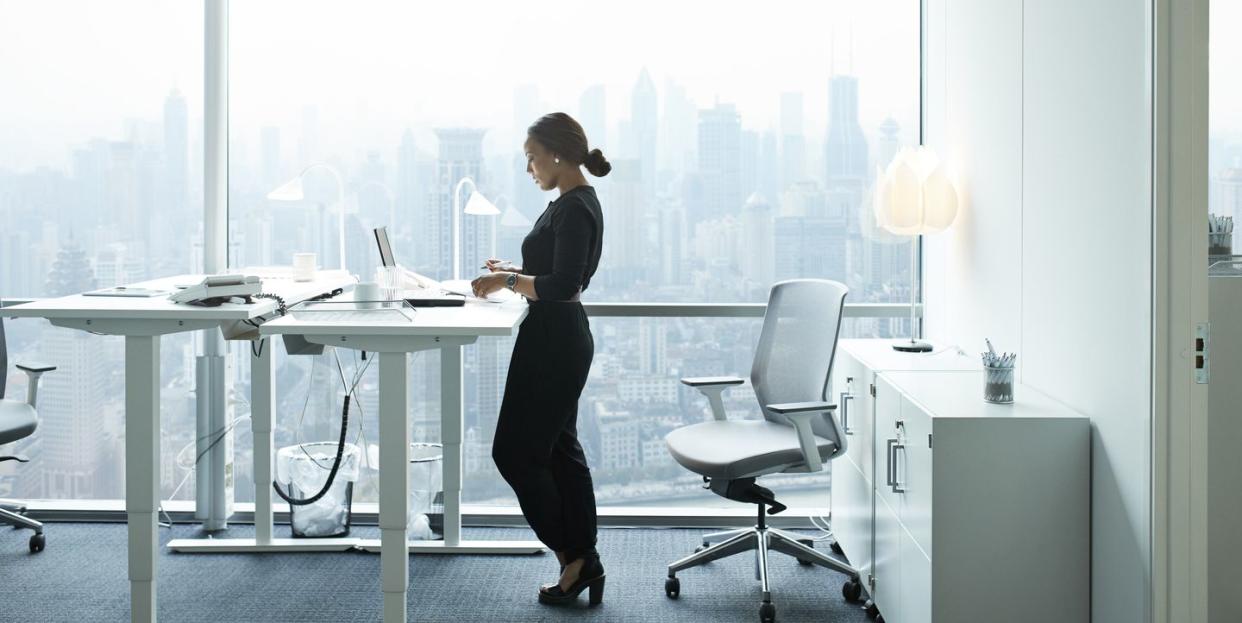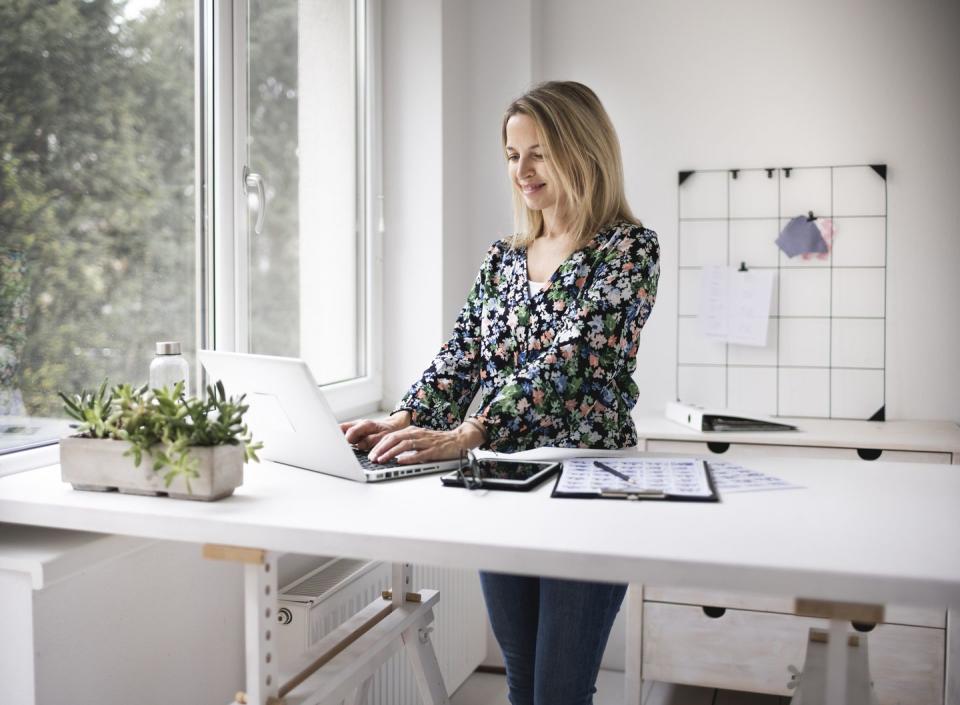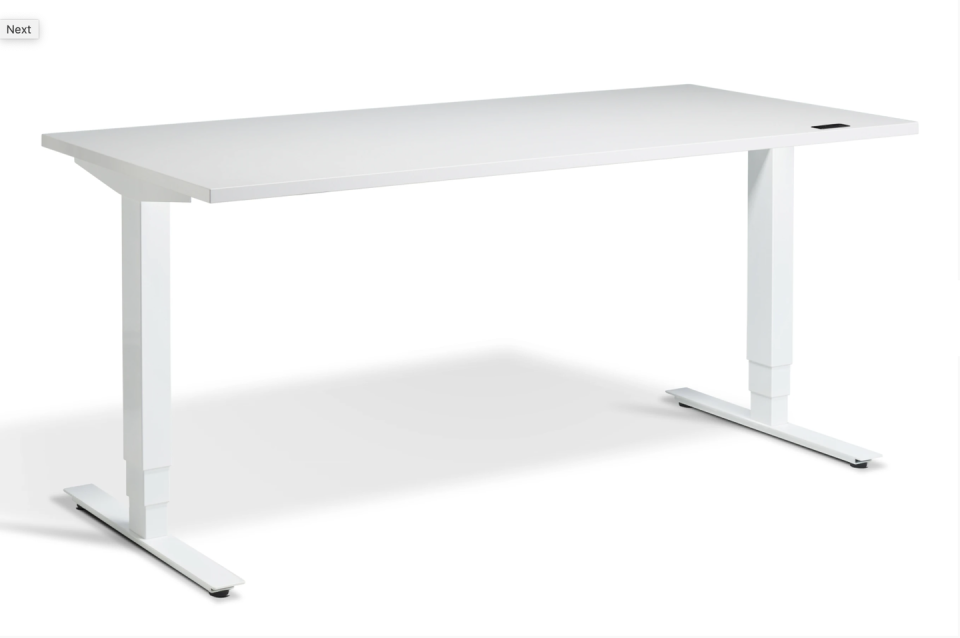Are standing desks worth it? We reviewed Friska's Stockholm desk

After more than a year of working remotely from the kitchen table, standing desks are becoming an increasingly popular way to alternate between sitting and standing during office hours. The ill-effects of a sedentary life are well documented by science, and switching to a height adjustable workstation has been proven to negate the harmful effects associated with sitting down for hours.
Thinking about investing, but not sure whether it's the right option for you? To find out whether standing desks really make a difference to your working day, we road-tested the Friska's Stockholm desk – you'll find our review below – and asked Kelly Greacen, physiotherapist at Ten Health & Fitness, and osteopath Garry Trainer to talk us through the benefits of breaking up with a stationary set-up:
Are standing desks better for you?
Also referred to as height-adjustable desks, or sit-stand desks, standing desks have some impressive health benefits. This isn't necessarily because standing has particular health benefits, but rather because you reduce the total time you spend sitting down. Being parked on your derriere for longer than eight hours per day can increase your risk of premature death or chronic diseases by between 10 and 20 per cent, research has shown.
Aside from potentially prolonging your life, one of the biggest benefits of switching to a standing desk are the protective effects on your spine. Unsurprisingly, back pain is one of the most common complaints among stationary office workers. 'When standing, if you have the correct posture and even-weight-bearing on both feet, your spine is going to be in a much more neutral position – as opposed to the slouch position,' says Greacen.
'Even if people have the perfect desk set up, you will get more and more tired as the day goes on, which will mean you naturally begin to slouch. Standing results in much less pressure on the spinal discs. Not only this, but when standing, you have the ability to tap into muscles a bit more and be a bit more active, such as your legs and arms. It gives the spine some stability and support, which is might not otherwise have in the sitting position.'
The benefits of standing desks
Scientific research is underway on the benefits of standing desks, and the early results are promising. Standing desks have been shown to:
Burn calories: Compared to an afternoon spent sitting, standing burns more than 170 extra calories, the University of Chester found.
Regulate blood sugar levels: Standing for 180 minutes reduces a lunch-induced blood sugar spike by 43 per cent compared to sitting, the University of Chester found.
Reduce stress: People who use standing desks are less stressed and have more energy than those who remain seated all day, researchers in Minnesota found.
Protect your heart: People who stand all day are 50 per cent less likely to die from heart disease-related deaths as those who sit all day, UK researchers found.
Ease back pain: Standing desks reduced upper back and neck pain by 54 per cent after four weeks, Minnesota-based researchers found.
'Today, four out of five people in the UK sit at a desk for more than seven hours,' says Trainer. 'Standing desks are great because they can be tailored to your height and size. The problem with many modern office environments is that many different people share the same style desk, which is static and non-changeable.
'Anyone who suffers with back, neck or shoulder pain which is aggravated by sitting for prolonged periods should really try working in the standing position and reap the benefits of increased productivity, mental alertness, less body pain and more calories burned.'
How long should you stand at a standing desk per day?
While there's no hard and fast rule, it's best to intersperse periods of sitting and standing. No sustained posture over a long time period is the right posture, Greacen explains – rather, it's variety that is key. 'If you do have a standing desk and like to work from there for the majority of the day, it’s important to keep moving whilst you're at the desk,' she says. 'This is because the effect of gravity will mean blood will go to your lower limbs more, and this is when blood pooling happens, which can cause issues such as varicose veins.'
To combat these effects, 'make sure you do movements such as "scrunching" your toes when you're standing, or doing some calf raises,' Greacen continues. 'These contract your muscles and force the blood out of your legs and back towards your heart. Marching on the spot or doing a few high knees is also a great way to activate the glutes when you've been standing for long periods of time, or even kicking your bottom. Anything to encourage movement on the lower half of your body is helpful.'

To get optimum benefits from your standing desk and reduce the risk of ill-effects, you should also make sure it's set up properly according to your stature. 'Stand straight on facing the desk, upright and not slouching,' says Trainer. 'Don't tense or brace your knees, as this causes tension in the neck and lower back. Keep the knees soft or very slightly bent and tilt the pelvis slightly forward. The desk should be at 90 degrees to your elbows with the keyboard and mouse at the same angle.'
Who shouldn't use a standing desk?
While standing desks offer a glute-load of health benefits when used correctly, they're not suitable for everyone. 'I would not advise pregnant women to hold any position for long periods of time – sitting or standing,' says Trainer. 'In the third and final trimester of pregnancy, a hormone called relaxin is released to prepare and soften the ligaments of the pelvis in preparation for birth. Unfortunately this can also have an effect on all ligaments of the body, rendering them looser and affecting their joint stabilising function.'
What is the best stand up desk on the market?
With such a long list of potential health benefits to reap, I was lucky enough to test Friska's electric standing desk, the Stockholm. Fitted with dual motors, it's said to be the quietest and quickest height adjustable desk available on the market ('whisper quiet', in fact), and finished in tough scratch-resistant powder coating for durability.
Having recently been diagnosed with piriformis syndrome as a result of prolonged sitting, I felt like a prime candidate. The condition occurs when a muscle in your lower back spasms, irritating your sciatic nerve and causing intense pain, numbness and tingling. Short of switching careers, the Friska desk seemed like the perfect solution.
After a period of working from a DIY standing desk (a 'tower' of 13 books with my laptop balanced precariously on top) I was raring to road-test the Stockholm. Friska offers free next day delivery to mainland UK if you order before midday, so it arrived quickly. After a brief miscommunication with the delivery driver – resolved with excellent customer service from Friska representative Mike – I set about unwrapping it all.
Friska advises that 'self-assembly requires a reasonable level of DIY ability', and there are tutorials on the website for anyone who needs them. The desk comes complete with all the screws and has pre-drilled holes, but you have to supply the tools yourself. It soon became clear that I'd need a second pair of hands – some parts are very heavy – so I called in reinforcements and within 45 minutes the Stockholm was ready to go.
My first observation was how sturdy the desk is. It's rock solid, even when fully extended. As a writer I'm constantly typing, which means I am immensely aware of even the slightest wobble. The Stockholm is reassuringly wobble-free, no matter how intensely I inadvertently slam the keys when on deadline. It can support up to 120kg in weight, and is wide enough to comfortably fit three monitors.
The height range is seriously impressive, starting at 595mm and increasing up to 1,300mm – suitable for people up to 6'8" tall – and the transition is genuinely seamless. The motors are super-smooth and won't spill your coffee while you're adjusting the table (even if you've accidentally filled the mug to the very top). While the Stockholm is not quite 'whisper' quiet, noise is definitely kept to a minimum. You could probably hear it on a Zoom call, but not from the next room.
The desk is fitted with a memory control switch featuring a digital screen and manual up and down controls. 'Memory control' means it allows you to save your preferred settings, so there's no unnecessary fiddling around with the height every time you want to stand up or sit down, which is a huge plus when you're in the middle of a work project.
One of the biggest draws has to be the design. The aesthetics are super fresh – clean, sleek, modern and minimalist. I went for the white option, but there are 18 different desktop colours and finishes to choose from. If you're worried about pesky wires cluttering the back of the desk and ruining the overall look, the cable management tray keeps them tucked out of view and clips/unclips easily should you need to add or remove any.

There was no question in my mind: the Stockholm is the best standing desk on the market. But could I get used to working sans-chair? I'll be brutally honest: after just two weeks of intermittent standing, I don't think I could ever go back to sitting for eight hours solid. It took some getting used to – at first, I found that if I stood for too long, my concentration and energy levels drooped – but after experimenting I've found a rhythm that works for me.
The only drawback? While I've experienced immense relief from piriformis pain, sometimes my lower back aches. Rest assured, that's perfectly normal at the beginning. 'It does take time to adjust to the new position and find your optimum working level,' says Trainer. 'It's a new position for the body, new muscle groups are coming in to play, and heel height could throw the back out further.'
The fix involves perseverance, patience and posture. 'You also have to be absolutely posture aware,' he says. 'No slouching! Keep shoulders from rolling forward and don't hunch over the desk. Regularly distribute the weight from side to side, by lifting up one leg and putting it on a leg rest. Have periods of time when you make a point of balancing on one leg and then the other.'
Visit the Friska Desk website here to find out more about their height-adjustable standing desks. Prices start from £729.
Last updated: 16-07-2021
You Might Also Like


